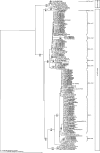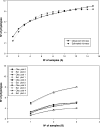Increased diversity of arbuscular mycorrhizal fungi in a long-term field experiment via application of organic amendments to a semiarid degraded soil
- PMID: 19429562
- PMCID: PMC2704833
- DOI: 10.1128/AEM.00316-09
Increased diversity of arbuscular mycorrhizal fungi in a long-term field experiment via application of organic amendments to a semiarid degraded soil
Abstract
In this study, we tested whether communities of arbuscular mycorrhizal (AM) fungi associated with roots of plant species forming vegetative cover as well as some soil parameters (amounts of phosphatase and glomalin-related soil protein, microbial biomass C and N concentrations, amount of P available, and aggregate stability) were affected by different amounts (control, 6.5 kg m(-2), 13.0 kg m(-2), 19.5 kg m(-2), and 26.0 kg m(-2)) of an urban refuse (UR) 19 years after its application to a highly eroded, semiarid soil. The AM fungal small-subunit (SSU) rRNA genes were subjected to PCR, cloning, single-stranded conformation polymorphism analysis, sequencing, and phylogenetic analyses. One hundred sixteen SSU rRNA sequences were analyzed, and nine AM fungal types belonging to Glomus groups A and B were identified: three of them were present in all the plots that had received UR, and six appeared to be specific to certain amendment doses. The community of AM fungi was more diverse after the application of the different amounts of UR. The values of all the soil parameters analyzed increased proportionally with the dose of amendment applied. In conclusion, the application of organic wastes enhanced soil microbial activities and aggregation, and the AM fungal diversity increased, particularly when a moderate dose of UR (13.0 kg m(-2)) was applied.
Figures




References
-
- Albaladejo, J., V. Castillo, and E. Diaz. 2000. Soil loss and runoff on semiarid land as amended with urban solid refuse. Land Degrad. Dev. 11:363-373.
-
- Albaladejo, J., R. Ortiz, and M. Martínez-Mena. 1988. Evaluation and mapping of erosion risks: an example from S.E. Spain. Soil Technol. 1:77-87.
-
- Alguacil, M. M., E. Lumini, A. Roldán, J. R. Salinas-García, P. Bonfante, and V. Bianciotto. 2008. The impact of tillage practices on arbuscular mycorrhizal fungal diversity in subtropical crops. Ecol. Appl. 18:527-536. - PubMed
-
- Alguacil, M. M., A. Roldán, and P. Torres. 2009. Complexity of semiarid gypsophilous shrub communities mediates the AMF biodiversity at the plant species level. Microb. Ecol. 57:718-727. - PubMed
Publication types
MeSH terms
Substances
Associated data
- Actions
- Actions
- Actions
- Actions
- Actions
- Actions
- Actions
- Actions
- Actions
- Actions
- Actions
- Actions
- Actions
- Actions
- Actions
- Actions
- Actions
- Actions
- Actions
- Actions
- Actions
- Actions
- Actions
- Actions
- Actions
- Actions
- Actions
- Actions
- Actions
- Actions
- Actions
- Actions
- Actions
- Actions
- Actions
- Actions
- Actions
- Actions
- Actions
- Actions
- Actions
- Actions
- Actions
- Actions
- Actions
- Actions
- Actions
- Actions
- Actions
- Actions
- Actions
- Actions
- Actions
- Actions
- Actions
- Actions
- Actions
- Actions
- Actions
- Actions
- Actions
- Actions
- Actions
- Actions
- Actions
- Actions
- Actions
- Actions
- Actions
- Actions
- Actions
- Actions
- Actions
- Actions
- Actions
- Actions
- Actions
- Actions
- Actions
- Actions
- Actions
- Actions
- Actions
- Actions
- Actions
- Actions
- Actions
- Actions
- Actions
- Actions
- Actions
- Actions
- Actions
- Actions
- Actions
- Actions
- Actions
- Actions
- Actions
- Actions
- Actions
- Actions
- Actions
- Actions
- Actions
- Actions
- Actions
- Actions
- Actions
- Actions
- Actions
- Actions
- Actions
- Actions
- Actions
- Actions
LinkOut - more resources
Full Text Sources
Molecular Biology Databases

